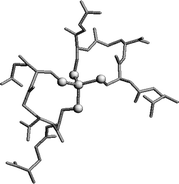The acid–base properties and cadmium binding abilities of (γ-Glu-Cys)2-Gly (PC2), a short phytochelatin, were studied in solution, using potentiometry, 1H NMR and UV-vis spectroscopy. Macroscopic and microscopic constants established by potentiometry and NMR allowed the complete dissociation processes of the hexaprotic PC2 molecule to be explained. The stoichiometry of the complexes formed by phytochelatin with cadmium depends very strongly on reactant ratios. For different amounts of ligand with respect to the metal ion the CdH2L and CdHL species exist in almost the same molar fractions. Above pH 6 complexes with one (CdL) or two ligand molecules bound (CdH3L2, CdH2L2, CdHL2 and CdL2, respectively) were found depending on the Cd(II)
∶ peptide ratio. 1H NMR and UV-vis spectroscopy show coordination of four sulfur atoms from two molecules of PC2 to one cadmium(II) ion (RCd–S: 2.52 Å). Amino groups, glutamic acid and glycine deprotonated carboxyls also participate in cadmium coordination, in contrast to thiolate groups, in monomeric complexes in acidic solutions. Quantitative comparison of metal ion binding strength by PC2 with low molecular weight peptide thiols (LMWT), glutathione and its fragments show that over a wide range of pH phytochelatin binds to cadmium(II) ions several times more strongly than LMWT.

You have access to this article
 Please wait while we load your content...
Something went wrong. Try again?
Please wait while we load your content...
Something went wrong. Try again?


 Please wait while we load your content...
Please wait while we load your content...